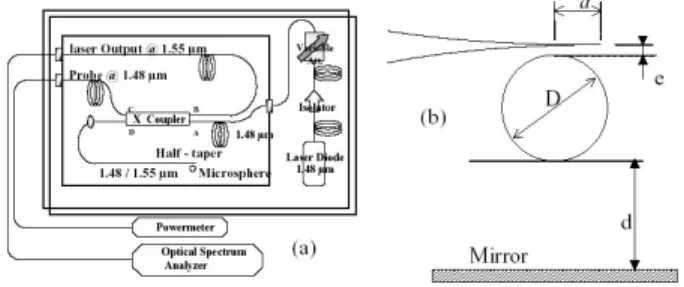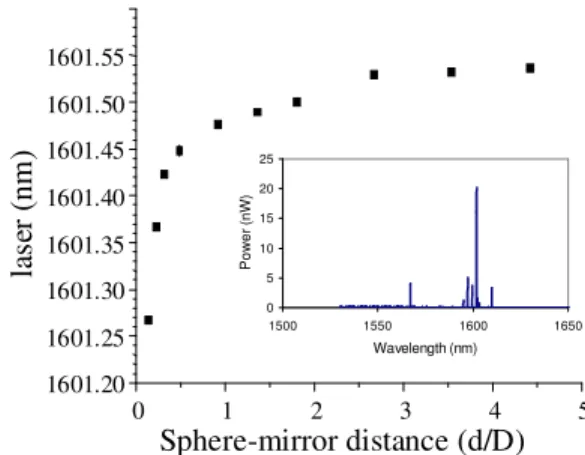HAL Id: hal-00160719
https://hal.archives-ouvertes.fr/hal-00160719
Submitted on 6 Jul 2007
HAL is a multi-disciplinary open access
archive for the deposit and dissemination of
sci-entific research documents, whether they are
pub-lished or not. The documents may come from
teaching and research institutions in France or
abroad, or from public or private research centers.
L’archive ouverte pluridisciplinaire HAL, est
destinée au dépôt et à la diffusion de documents
scientifiques de niveau recherche, publiés ou non,
émanant des établissements d’enseignement et de
recherche français ou étrangers, des laboratoires
publics ou privés.
Microspherical laser in Erbium-Ytterbium-doped glass
Gualtiero Nunzi-Conti, Carole Arnaud, Mohamed Boustimi, Patrice Feron,
Stefano Pelli, Giancarlo Righini
To cite this version:
Gualtiero Nunzi-Conti, Carole Arnaud, Mohamed Boustimi, Patrice Feron, Stefano Pelli, et al..
Mi-crospherical laser in Erbium-Ytterbium-doped glass. 10th MicroOptics Conference (MOC’04), 1-3
september 2004, Sep 2004, Jena, Germany. �hal-00160719�
Microspherical Laser In Erbium-Ytterbium-Doped Glass
G. Nunzi Conti (1), C. Arnaud (2), M. Boustimi (2), P. Féron (2), S. Pelli (1), G.C. Righini (1)
(1) Istituto di Fisica Applicata ‘N. Carrara’, IFAC CNR, Via Panciatichi 64, 50127 Firenze, Italy; g.nunziconti@ifac.cnr.it (2) Laboratoire d’Optronique (CNRS-UMR 6082 - FOTON), ENSSAT, 6 rue de Kerampont, 22300 Lannion, France
Abstract: We present experimental results on a Er3+/Yb3+ doped microspherical laser. Our experiments have been focused on the 4I
13/2→4I15/2 transition at 1550 nm of erbium ions in phosphate glass spheres. We also report on the effects that the interaction
between the WGM modes of the glass sphere and an external metallic mirror has on the laser emission.
Keywords: Whispering Gallery Mode, Erbium, Microlaser, Optical Feedback
1. Introduction
In dielectric spheres light can be guided through high-Q whispering-gallery-modes (WGMs) with an unique combination of strong temporal and spatial confinement of light. Glass microspheres are then of interest for a large number of applications as cavity quantum electrodynamics [1], nonlinear optics [2], photonics [3] and chemical or biological sensing [4]. Since the early works of Garret et al [5] and the works on Morphology Dependent Resonances (MDRs) and lasing effects in droplets during the 1980's [6], rare earth doped glass microsphere lasers recently became subject of numerous studies and have been demonstrated as potentially compact laser sources [7,8].
We present experimental results on microspherical laser emitting around 1550 nm and pumped at 1480 nm using half-taper for direct light coupling. Our experiments are focused on the transition 4I
13/2→4I15/2 of Er3+ ions in Er3+/Yb3+ co-doped phosphate glass microspheres with emission in the L and C telecommunication bands. We report preliminary results of our investigation on the effect that the interaction between the WGM modes of the glass sphere and an external metallic mirror has on the laser emission. Johnson [9] presented a theoretical treatment of the MDRs of a dielectric sphere in close proximity to a surface of infinite conductivity and calculated the changes of the locations of the resonances as the sphere approaches the surface. We decided to further investigate this phenomenon and we analysed both the wavelength and the intensity of the emitted signal of a microspherical laser as a function of the distance from a silver or a gold mirror.
2. Experiment
The phosphate glass used was an Er3+/Yb3+ co-doped phosphate glass (Schott IOG-2) doped with 2% weight of Er2O3 and co-doped with 3% weight of Yb2O3. Though the use of Ytterbium co-doping is traditionally associated to 980 nm pumping wavelength, we chose instead 1480 nm as the pumping wavelength in order to obtain a good overlap between the pump and the laser mode volumes in the microsphere. Ytterbium ions were used only to reduce some of the drawbacks of a very high Erbium concentration (1.7·1020 ions/cm3) like self pulsing or concentration quenching [10].
Spheres were produced by fusion of glass powders with a microwave plasma torch. Powders were injected axially and melt when passing through the flame, superficial tension forces giving them their spherical form. Free spheres with a diameter which varies from 10 to 200 µm were collected a few centimeters below. They were then glued to a stretched tip of an optical fiber (~20
µm in diameter) which was then mounted on a
submicrometer translational stage.
To excite high-Q WGMs light has to be launched from a phase-matched evanescent wave of an adjacent waveguide such as an angle polished or a tapered fiber or a prism under total internal reflection [11-13]. We used a single half-fiber-taper which couple the pump light in the microsphere and - at the same time - allows to couple the fluorescence or laser light out of the microsphere. This half-taper was obtained using a fusion splicer by heating and stretching a standard telecommunication fiber until breaking. The drawn length was typically 850 µm, and the taper end was reduced down to 1.5 µm in diameter. The experimental setup is sketched in Fig. 1a. The pump is a laser diode (maximum power 1 W) operating around 1.48 µm. A WDM X-coupler at 1.48-1.55 µm allowed us to use the same fiber to pump and to collect the fluorescence or the laser signal. This latter was analyzed with a 70 pm resolution Optical Spectrum Analyzer (OSA). For the experiment with an external cavity, the metallic flat mirror was mounted on a microtranslational stage below the micro-sphere (Fig. 1b).
Fig. 1. (a) Experimental setup and (b) geometry of the coupling beetween the microsphere and a metallic mirror.
3. Results
For any sphere diameter, the optical spectrum of the laser below the threshold showed an enhancement of the fluorescence intensity and a higher peak density than those obtained coupling light with a prism, as demonstrated in a previous paper [13]. More modes can thus be excited in the sphere even above threshold. Inset of Figure 2 shows WGMs laser spectra for an isolated microsphere (d>>D) with a diameter D~70 µm. Peak
laser emission is obtained around 1601 nm as the gap e is rather large and a low pumping ratio is used. For a lower gap value associated to an higher pumping ratio we have obtained laser effects at lower wavelengths [14].
A large body of literature has been written on WGMs or MDRs but most of the research has focused on cases in which the sphere can be considered to be isolated, i.e, there are no strong perturbing effects from other nearby particles or surfaces. The WGM's of a sphere resting on a surface or with close neighboring particles is also of theoretical and practical interest [8,15,16]. Johnson's theoretical treatment [9] of the MDR's of a dielectric sphere near a plane of infinite conductivity examines how the locations and widths of the resonances change as the sphere approaches the surface. If a sphere of diameter D is initially located at a distance d that is more than approximately 2D/3 away from the point of contact with the conducting plane, the resonances will have the same locations and widths as they do in an isolated sphere. Then, as the sphere is brought closer to and eventually in contact with the surface, the locations and widths of the resonances change. Most of the change in location and width occurs when the sphere is quite close to the conducting plane. Approximately 90% of the total resonance shift occurs when the distance from the point of contact is less than 0.05 of the diameter of the sphere. We used a silver or a gold mirror with no dielectric coating over the reflective surface. This seems to be the closest approximation to the idealized case of the perfect mirror of infinite conductivity for which the method of images is strictly valid [9]. At this point, it is important to say that with our experimental setup, we could not approach the mirror closer than d=3.5 µm. For our
typical size of sphere (D~70 µm) dmin/D=0.05 so we cannot explore the zone where Johnson predicted 90% of the effect. However, we noticed an influence of the mirror on both fluorescence and laser lines for distances up to 2.5D. With the coupling that gave a laser emission around 1600 nm we approached the mirror from d=175
µm to d=7 µm. We observed a line shift of almost 0.3 nm
towards the lower wavelength (Fig. 2) associated to an enhancement of the intensity. For a lower wavelength, the mirror approach induced the same "blue shift" but also caused the laser extinction while increasing the threshold [14].
4. Conclusions
WGMs lasing action was obtained in Er3+/Yb3+ doped phosphate glass with high Erbium concentration. We
observed a blue-shift of the lasing wavelength of 0.3 nm while varying the distance between the sphere (of diameter D) and an external mirror from 2.5 to 0.1 D.
Acknowledgement
This work was partially supported by MIUR, Italy, through the FIRB project ”Sistemi Miniaturizzati per Elettronica e Fotonica” and by a collaboration act between CNRS and CNR.
References
[1] L. Collot, V. Lefèvre-Seguin, M. Brune, J.M. Raimond, S. Haroche, Europhys. Lett. 23,327 (1993).
[2] R.K. Chang, A.J. Campillo, Optical processes in microcavities, World Scientific, Singapore (1996).
[3] B.E. Little, J.P. Laine, D.R. Lim, H.A. Haus, L.C. Kimerling, S.T. Chu, Opt. Lett. 25, 73 (2000).
[4] F. Vollmer, D. Braun, A. Libchaber, M. Khoshsima, I. Teraoka, S. Arnold, Appl. Phys. Lett. 80, 4057 (2002).
[5] C.G.B. Garret, W. Kaiser, W.L. Long, Phys.Rev. 124, 1807
(1961).
[6] P.W. Barber, R.K. Chang, Optical effects associated with small particles, World Scientific, Singapore (1988).
[7] V.S. Sandoghdar, F. Treussart, J. Hare, V. Lefèvre-Seguin, J.M. Raimond, S. Haroche, Phys. Rev. A 54, 1777, (1996).
[8] F. Lissillour, P. Féron, N. Dubreuil, P. Dupriez, M. Poulain, G. Stéphan, Elect. Lett. 36, 1382 (2000).
[9] B.R. Johnson, J.O.S.A. A 11, 2055 (1994).
[10] T. Ohtsuki, S. Honkanen, S. I. Najafi, N. Peyhambarian, J.O.S.A.. B, 14 (7), 1838 (1997).
[11] M. Cai, K. Vahala, Opt. Lett. 25, 260 (2000).
[12] V.S. Ilchenko, X.S. Yao, L. Maleki,Opt. Lett. 24, 723
(1999).
[13] F. Lissillour, D. Messager, G.M. Stéphan, P. Féron, Opt. Lett. 26, 1051 (2001).
[14] C. Arnaud, M. Boustimi, P. Féron, G. Nunzi Conti, G. Righini, SPIE Proc. 5333, 140 (2004).
[15] K.A. Fuller, Appl. Opt. 28, 3788 (1989); K.A. Fuller,
Appl. Opt. 30, 4716 (1991).
[16] S.C. Hill, R.E. Benner, C.K. Rushforth, P.R. Conwell, Appl. Opt. 23, 1680 (1984).
Fig. 2. Lasing wavelength vs sphere mirror distance around 1601 nm. Inset shows the multimode laser effect with the peak at 1601 nm for the isolated sphere (D~70 µm).
0 1 2 3 4 5 1601.20 1601.25 1601.30 1601.35 1601.40 1601.45 1601.50 1601.55 Sphere-mirror distance (d/D) la se r ( nm ) 0 5 10 15 20 25 1500 1550 1600 1650 Wavelength (nm) P ow er (n W )

